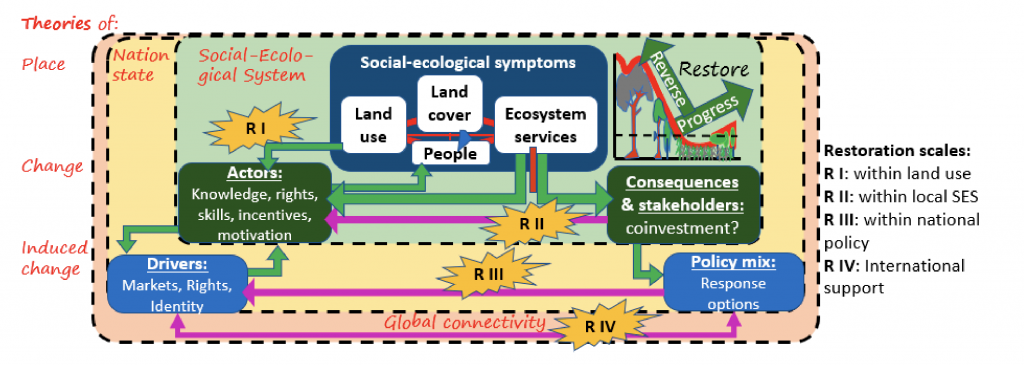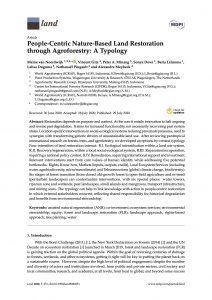Originally published on the World Agroforestry website.
Restoration of degraded forests and landscapes is becoming increasingly important thanks to major commitments, such as the Bonn Challenge, the New York Declaration on Forests and the UN Decade on Ecosystem Restoration. Restoration work is now underway around the world, including through the 15 agricultural research centres that make up the CGIAR, a global science partnership for a food-secure future.
To assess effectiveness and assist with speeding restoration, the CGIAR Research Program on Forests, Trees and Agroforestry (FTA) made restoration one of its research priorities. FTA teamed up with two other research programs — Policies, Institutions and Markets; and Water, Land and Ecosystems — to undertake a joint stocktake of the work on forest and landscape restoration of several of the CGIAR’s member centres. The synthesis study was published on 3 August 2020.
The three research programs agreed on a broad scope of restoration, focused on the restoration of ‘ecological functions’ and efforts to halt ongoing and reverse past degradation by aiming for increased functionality but not necessarily recovering past system states.
Building upon this work, a team of FTA researchers worked on a typology of the different approaches to restoration, now published in the journal, Land.
‘We identified the need to uncover the diverse understanding and perspectives about “restoration” and to construct a typology that can help to clarify contrasts, similarities and possible synergies,’ said Meine van Noordwijk, distinguished research fellow with World Agroforestry (ICRAF) and lead author of the study. ‘The aims of the typology are to better describe the links between evolving knowledge, stakeholder-driven action, and achievement of the Sustainable Development Goals.’
This is important because with the goal of reversing centuries of damage to forests, wetlands and other ecosystems, getting it right is key to putting the planet back on a sustainable course. However, despite the high level of political engagement and the number and diversity of people and institutions involved from the public and private sectors, civil society and local communities, research and academia, restoration is not happening at a wide scale across the globe.
The key to this problem is whether restoration goals and means are aligned with the priorities of the people who live in, and gain their long-term livelihoods from, the landscapes to be restored.
The typology has three main components. First, it distinguishes four levels of restoration, ranging from the lowest level of intensity of intervention to the highest:
- Ecological intensification;
- Recovery and regeneration;
- Reparation and recuperation; and
- Remediation.

Second, the huge diversity of interventions possible in this range can be broadly classified into
- Leave alone;
- Assisted or managed natural regeneration; and
- Tree and grass planting.
The third component is a typology of contexts, which is fundamental to understanding the suitability and effectiveness of an intervention. The typology of contexts is based on the forest transition concept: 1) forest fraction; 2) forest configuration (core, edge and mosaic); and 3) human population density, with the addition of six ‘special places’ because of their specific importance in interactions between ecosystem functions and human activities: 1) watertowers; 2) riparian zones and wetlands; 3) peat landscapes; 4) small islands and mangroves in coastal zones; 5) mining scars; and 6) transport infrastructure. Further descriptors of context that are relevant for restoration are the climatic zones and soil properties.
‘The typology will be useful in view of the lack of such structured interpretations,’ said van Noordwijk. ‘It can support further studies on the effectiveness of interventions in different contexts.’
 The complete typology can be found in the open-access article, People-centric nature-based land restoration through agroforestry: a typology, in the journal Land.
The complete typology can be found in the open-access article, People-centric nature-based land restoration through agroforestry: a typology, in the journal Land.
Learn more about the typology
Van Noordwijk M, Gitz V, Minang PA, Dewi S, Leimona B, Duguma LA, Pingault N, Meybeck A. 2020. People-centric nature-based land restoration through agroforestry: a typology. Land 9(8). https://doi.org/10.3390/land9080251
Read about the joint stocktaking work on forest and landscape restoration
Gitz V, Place F, Koziell I, Pingault N, van Noordwijk M, Meybeck A, Minang P. 2020. A joint stocktaking of CGIAR work on forest and landscape restoration. Working Paper 4. Bogor, Indonesia: CGIAR Research Program on Forests, Trees and Agroforestry.
About World Agroforestry (ICRAF)
World Agroforestry (ICRAF) is a centre of scientific and development excellence that harnesses the benefits of trees for people and the environment. Knowledge produced by ICRAF enables governments, development agencies and farmers to utilize the power of trees to make farming and livelihoods more environmentally, socially and economically sustainable at multiple scales. ICRAF is one of the 15 members of the CGIAR, a global research partnership for a food-secure future. We thank all donors who support research in development through their contributions to the CGIAR Fund.
About the CGIAR Research Program on Forests, Trees and Agroforestry (FTA)
The CGIAR Research Program on Forests, Trees and Agroforestry (FTA) is the world’s largest research for development program to enhance the role of forests, trees and agroforestry in sustainable development and food security and to address climate change. CIFOR leads FTA in partnership with Bioversity International, CATIE, CIRAD, INBAR, ICRAF and TBI. FTA’s work is supported by the CGIAR Trust Fund.











